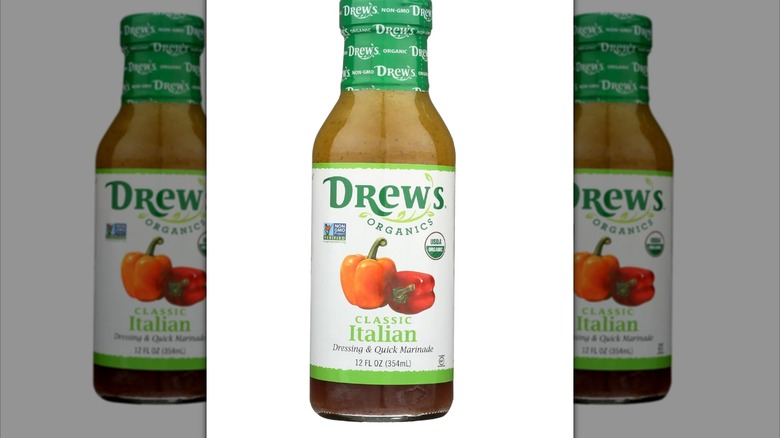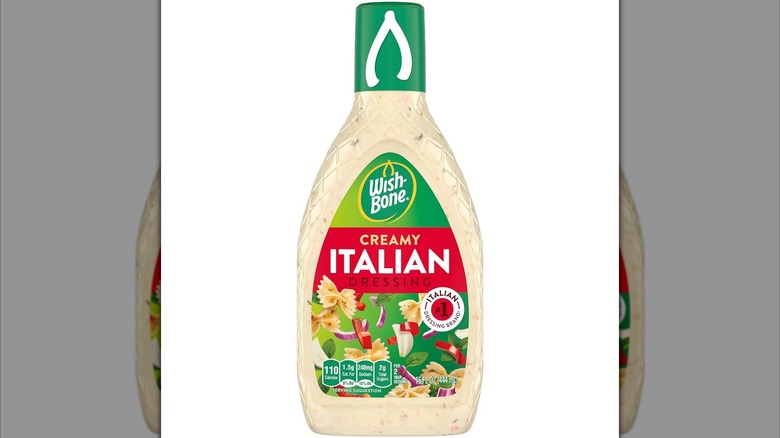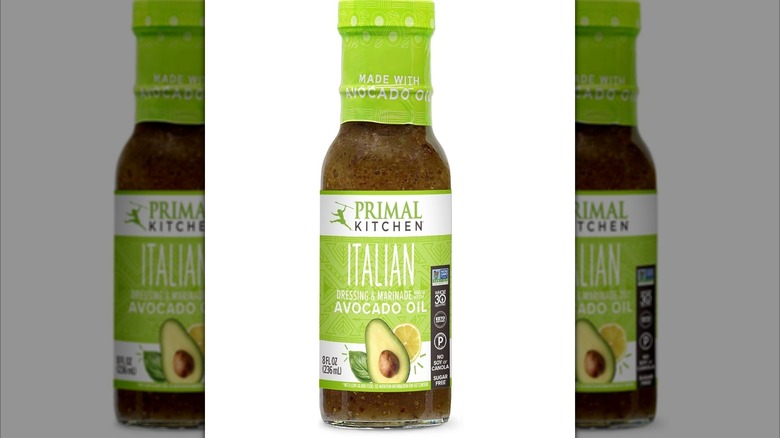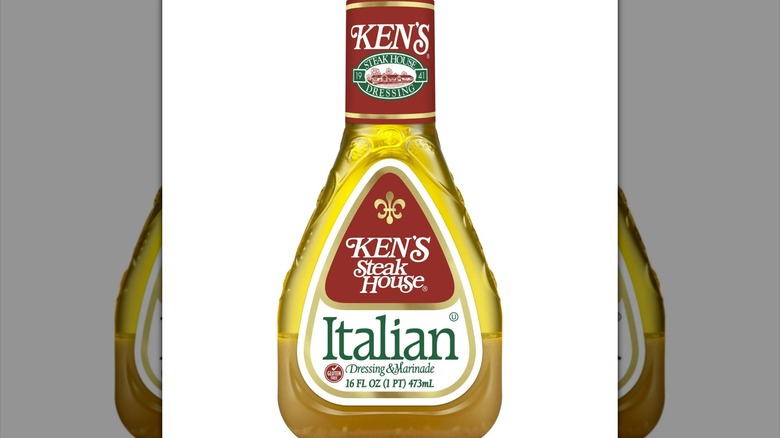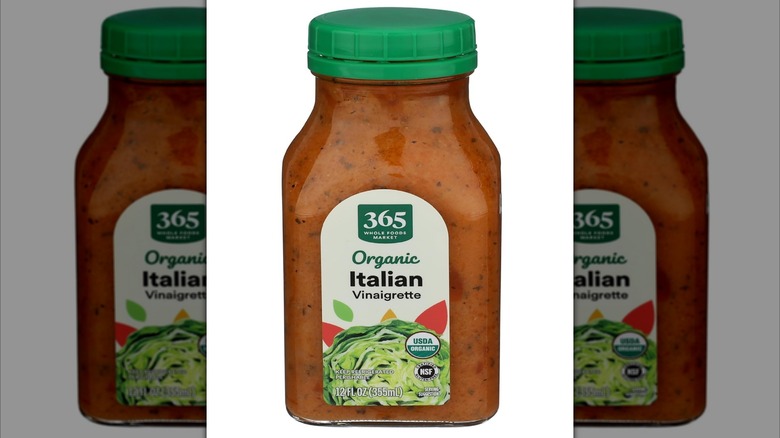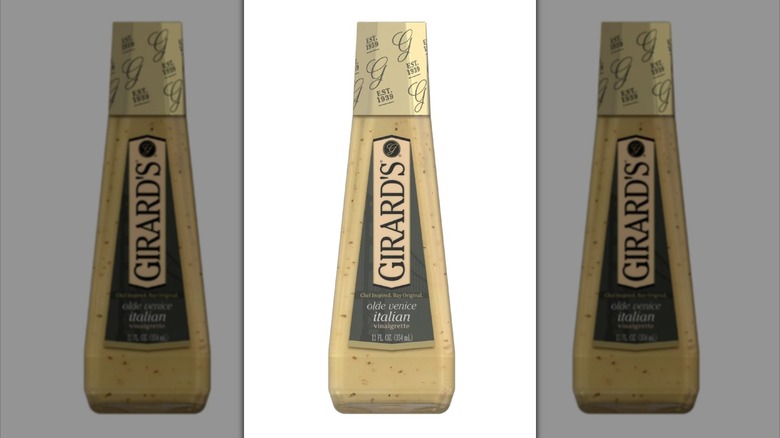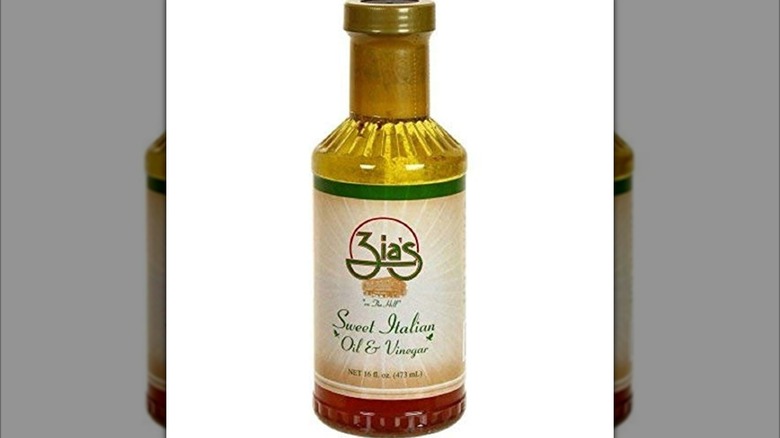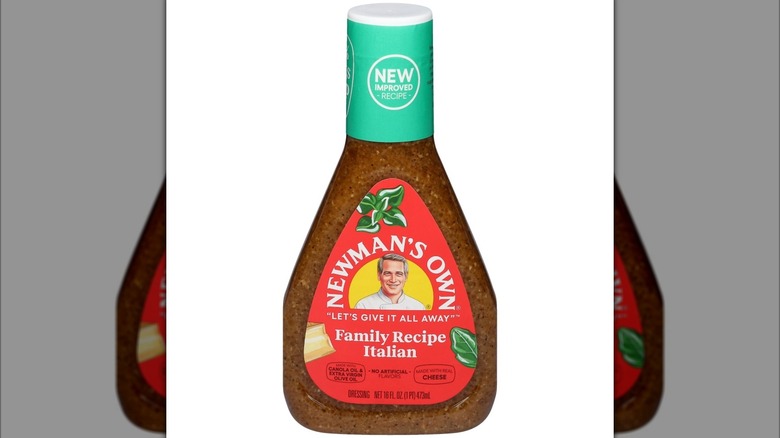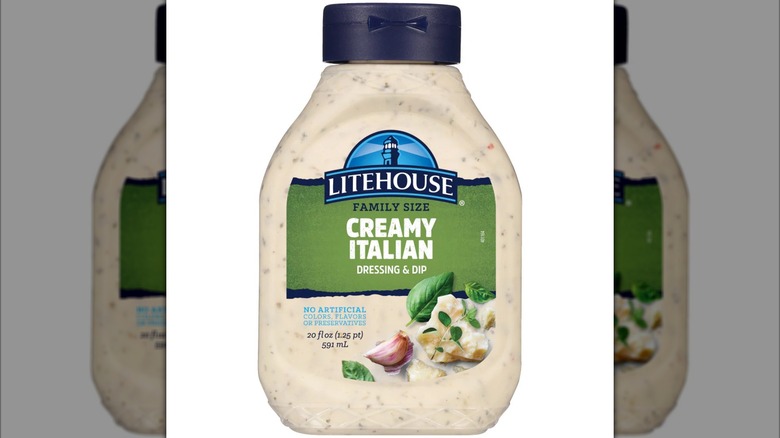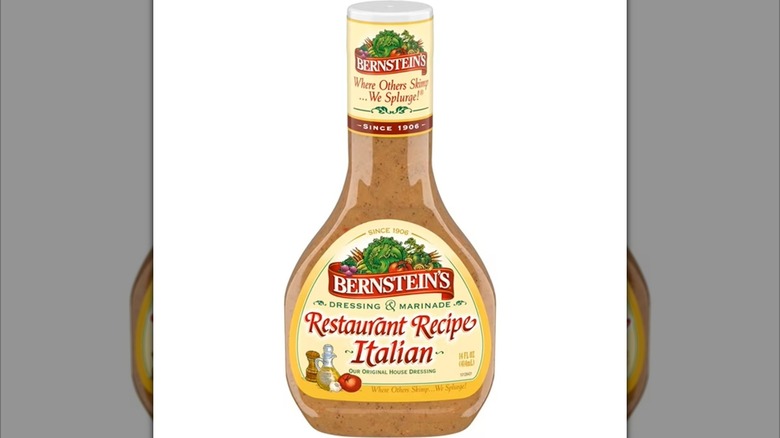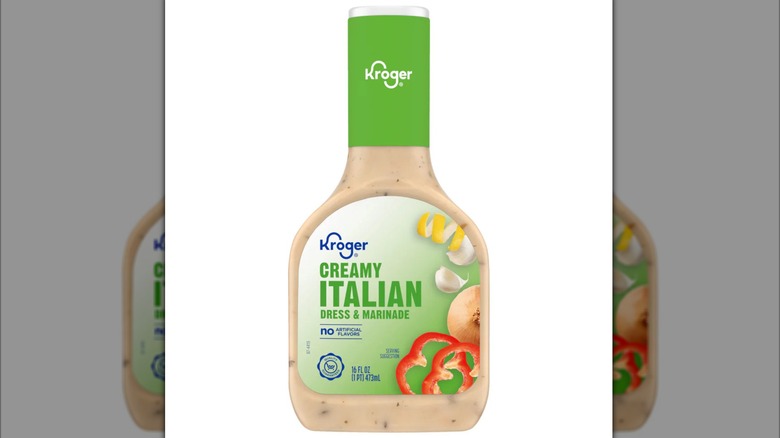11 Of The Unhealthiest Store-Bought Italian Salad Dressings
We may receive a commission on purchases made from links.
The most basic dressing you could ever conjure up to make your simple homemade salad a tastier affair has to be Italian vinaigrette. A basic blend of oil, vinegar, and zesty spices come together to share space on your greens and veggies with a familiar yet satisfying flavor combination. But glide down the salad dressing aisle of your local grocery store and you'll discover that every brand on the shelf has its own unique tweak on the original formula. In almost every instance, those tweaks alter the nutritional value in ways conscious consumers should be aware of. If you're not in the mood to tackle a homemade Italian dressing recipe to make sure your dietary needs are met, you should at least know which of these bottles doesn't share your concerns for your well-being.
I scanned the info for bottle after bottle of the best and worst store-bought Italian dressings to uncover a reasonable baseline for calories, fat, and sodium content. The most favorable composition nets you between 45 and 70 calories, 7 grams of fat, and fewer than 400 milligrams of sodium per 2 tablespoon serving. Using this as a touchstone, I hunted down the unhealthiest Italian dressings hiding among the whole pack. If you're hoping to watch your intake of some pretty gnarly macros while giving your salad a solid kick of flavor, these brands are best avoided in service of your dietary demands.
Drew's Organics Classic Italian
One of the most egregious oversteps in the realm of Italian dressing comes from Drew's Organics, a wellness brand that goes for a fully-organic ingredient list yet also comes up with far higher-than-average quantities of the not-so-cool stuff. While you can feel good about skipping any weird additives or untoward ingredients grown under questionable conditions, you might think twice about downing 150 calories, 17 grams of fat, and 220 milligrams of sodium in two measly tablespoons of dressing. If that's not enough to get your radicchio and radishes nice and flavored up, adding anything more is taking you into the weeds.
Thinking a more upmarket dressing would be a more healthful prospect is a common mistake to make when assembling a salad; many luxe add-ons aim for enhanced enjoyment rather than the utmost in nutrition. Even with organic components comprising the salad juice, Drew's somehow sidesteps the notion that a lower calorie Italian dressing with less fat and sodium pairs better with a label boasting a natural profile overall. I guess it's true that you can't have everything, even when it comes to something as simple as Italian dressing.
Wish-Bone Creamy Italian
The minute you hear that a dressing goes from its usual state to creamy, you can usually bet that something untoward is happening with the nutritional facts as well. And so it is with Wish-Bone Creamy Italian, a luxurious twist on the original recipe that cranks up the unhealthiness while piling on the enjoyability. With a single serving adding 110 calories, 10 grams of fat, and 240 of sodium to your veggie sticks, all the healthful good eating you were planning gets tossed. It may not be cause for a Wish-Bone salad dressing recall, but it's reason enough to strike this bottle from your shopping list.
Since apparently you can't depend on buttermilk to ratchet up the creaminess enough, Wish-Bone also tosses in some thickeners that could probably be omitted. Not only does the non-creamy version of Wish-Bone Italian contain fewer thickening agents, it also offers a more favorable 80 calories, 7 grams of fat, and 350 milligrams of sodium per serving. If you're wishing for a healthier salad topper, stick with good-old regular vinaigrette instead of letting the creamier version cream your thoughtful eating habits.
Primal Kitchen Italian Vinaigrette
You might think that a brand of Italian dressing called Primal Kitchen is going for something more natural and more beneficial to your body. Despite the misleading, Primal Kitchen pushes its Italian vinaigrette into the world with more of the undesirable stuff then you might be willing to consume. If a modest single serving racking up 110 calories, 12 grams of fat, and 230 milligrams of sodium is more than you were expecting from your salad dressing, this bottle is bound to blow your nutritional caution out of the water.
What accounts for the elevated calories in a dressing that doesn't veer so far off the beaten recipe path? There's nothing wild on the ingredient list that stands out as a savage offender. Maybe there's a higher concentration of oil, which comes in the form of the health-friendly avocado oil. But more oil in the bottle could mean more calories and fat on your salad, and if every salad dressing maker in the jungle has its own proprietary concoction, then it could be a thorny path to satisfying your dietary restrictions with this burdensome beast of a dressing.
Ken's Steak House Italian
Ken's Steak House stakes its claim on the salad dressing aisle with a slate of selections that give salad juice an upscale presence without requiring access to a specialty grocery store. While this is nice for a special occasion or celebration dinner, there's no justifiable cause to drizzle this company's Italian dressing over your iceberg unless you're ready to put in a little more time on your soul cycle. With its 150 calories, 17 grams of fat, and 460 milligrams of sodium cascading out of every 2 tablespoon serving, it's definitely not nutrition on the hearts and minds of the Ken's kitchen folk crafting this creation. The company is aiming for enjoyment over trimming your consumption of less-preferable components.
How do the disagreeable digits get so jacked up? There's nothing wacky or wild in the mix. Ken's uses both distilled and apple cider vinegar to conjure up a zesty flavor. The only seasonings listed on the ingredient list are garlic and onion, and even those are quantified as less than 2% of the whole shebang. So the culprit causing the calorie and fat count must be the canola oil, which does the heavy lifting while adding heft to your dietary intake.
365 by Whole Foods Market Organic Italian Vinaigrette
The word "organic" in 365 by Whole Foods Market Organic Italian Vinaigrette might fill you into thinking that everything in the bottle is beneficial to your well-being. What it doesn't tell you is that your calorie and fat count per serving will be increasing in service of drowning your bagged spring mix in this Whole Foods dressing. In exchange for 2 tablespoons of salad sauce, your bloodstream receives 100 calories, 10 grams of fat, and 240 milligrams of sodium. It's not the worst of the worst out there, but it is more than you may be bargaining for when the bottle decorates your Swiss chard with Italian inventiveness.
A trio of oils — soybean, canola, and sunflower seed — brings in the calories and fat here, while sugar does its share for increasing the calorie count as well. Though Amazon steps in to put this store label within reach for anyone without a Whole Foods in their neighborhood, it's probably better to keep shopping for a lighter take on a lettuce-improving drizzle in your quest for zest.
Girard's Old Venice Italian
Ah, to enjoy a zesty grilled chicken breast marinated in Gerard's Old Venice Italian dressing. It might taste like the next best thing to being in Italy, but a peek at the label should alert you to the compromise you'll be making to your daily recommended allowance of several components that you'd rather keep to a minimum. When a single serving carries 120 calories, 13 grams of fat, and 420 milligrams of sodium and you're soaking your cutlets in who-knows-how-many tablespoons of the stuff, you're looking at quite a tally going against your nutritional budget.
Molasses can be found further down the ingredient roll call, which may contribute a little extra in the calorie column; there's also a bit of sugar that makes its own donation to the cause. Whether this doubling down on sweeteners is worth the potential drawbacks to your recommended daily allowances — especially when they're being spent on salad dressing, of all things — is, of course, a personal choice. But wouldn't you rather go with a more favorable way to dampen your greens or perk up your chicken and save the sugar for dessert? Sure you would.
Zia's Sweet Italian Oil & Vinegar Salad Dressing
"Zia" is Italian, which gives Zia's Sweet Italian Oil and Vinegar Salad Dressing a sense of homemade comfort — especially if you speak Italian. Just like a loving aunt who only wants you to be happy, this supreme shake over is designed to soothe your hunger, if not to keep your health front of mind. Maybe if your zia knew each serving came with a colossal 150 calories, 14 grams of fat, and 290 milligrams of sodium, she'd alter the recipe and come up with something less compromising to your wellness.
Filling up the flavor quotient with a few extras, Zia's adds in a bit of sugar and a little Parmesan, both of which are sure to add to the calorie count. There's also a pair-up of olive and soybean oil, a tag team that may increase the fat and calorie content as well. All in all, this is one of the least healthy compositions that cropped up in my search, a finding which reinforced the idea that simpler is better when it comes to the contents of an Italian dressing bottle.
Newman's Own Family Recipe Italian
Newman's Own has a reputation for providing more mindful products ranging from pasta sauce to condiments. Though the ingredients might be of a more wholesome nature, you can't count on Newman's Family Own Recipe Italian dressing to share your personal dietary concerns. Evidence of this: the 120 calories, 13 grams of fat, 310 milligrams of sodium you'll be getting per serving, just to make your arugula a little more palatable. A combination of canola and olive oil, plus a high-on-the-list inclusion of Romano cheese and sugar is where this mix gets gooey. There's also sugar, corn syrup, and molasses in the Worcestershire sauce used, as well as corn syrup in the barley malt powder on the label. Is this a salad dressing or an ice cream topping?
Maybe the untold truth about Newman's Own is that even with the social and environmental goodness the brand espouses, the nutritional make-up of certain items tends toward decadence rather than dietary responsibility. It's a definite balancing act to decide whether the good causes are worth compromising your greater wellness, especially if you're watching your macros and incorporating more salads into your regimen. For anyone who'd rather stick with a more restrained version of a tangy vinaigrette, wave Newman's Own Family Recipe goodbye and move on to a more mindful brand.
Litehouse Creamy Italian
Yes, Litehouse is spelled like light food, and a not-so-subliminal signal that you'll be in good hands with anything you choose from this brand. But if you're tracking your intake of tricky elements in your salad syrup, you might consider Litehouse Creamy Italian a beacon warning you away from the rocky coastline of questionable nutritional content. Ignore the warning and you'll be steering your ship of decent eating straight into 100 calories, 10 grams of fat, and 190 milligrams of sodium for a single 2 tablespoon serving. Dietary detour dead ahead!
The Litehouse label is quick to point out its omission of high fructose corn syrup, as well as gluten, artificial colors and flavors, and preservatives. But what it lacks in those, it makes up in egg yolk, Parmesan cheese, two to three types of oil, and sugar. It's certainly not the most raucous concoction you could choose, but it's shifty enough to make a different consideration while you have a whole aisle of dressings in front of you. If you prefer smooth sailing when it comes to counting up your macronutrients by meal, give this Litehouse a wide berth and find a less tumultuous way to top your microgreens.
Bernstein's Restaurant Recipe Italian
It sounds like fun recreating a restaurant style dining experience at your own table, but it's important to remember that restaurants equal indulgence, which is why cautious eaters have gotten used to ordering their salad dressing on the side. Bernstein's Restaurant Recipe Italian goes for a more luxurious version of the usual mix, resulting in a higher than desired quantity of those sticky wickets that makes keeping your internal systems working at optimal capacity. With a simple tip of the bottle spilling out 100 calories, 11 grams of fat, and 280 milligrams of sodium, the sheen wears off pretty quickly, leaving you with a puddle of regret making your kale more palatable.
You may already suspect that the underlying reason Italian dressing tastes better at restaurants is because it's made for pleasure, not necessarily for health. Bernstein's walks the line with its restaurant-level dressing, dialing up the enjoyment factor with both Romano and cheddar cheese, plus Worcestershire sauce that includes molasses, corn syrup, sugar, and apple juice concentrate. Reading a recipe like that, you start to understand that sweetness is a big deal for this food producer, even in a dressing that does better with a bit of tartness. Sure, it tastes good, but it's not your prime purchase for keeping your nutritional mathematics square.
Kroger Creamy Italian
If you go for a less-expensive option like Kroger's Italian vinaigrette, you'll have smooth sailing with a very modest take on Italian dress. However, if you slide over one or two items on the shelf and pick up Kroger Creamy Italian, you're suddenly in dodgy territory, all for the sake of incorporating something posher into your eating plans. Squeeze a squiggle of this lush stuff over your crudité and you'll be going gonzo with 120 calories, 13 grams of fat, and 480 milligrams of sodium — enough of a no-no to negate your nifty nutritional navigation.
Lay the map of nutritional knowledge for this dressing side-by-side with its non-creamy Kroger Italian cohort, which has 80 calories, 7 grams of fat, and 330 milligrams of sodium, and you start to see that every step taking to make the texture and taste more inviting also works against your healthful eating dreams. When the process incorporates high fructose corn syrup and sugar into the works, you know things are going to be less than ideal. Since this store label affords you a less expensive gloss for your chicory and chard than some of the national brands, you're better off with the non-creamy version for a combination of affordability and dietary responsibility.
Methodology
The most uncomplicated way for me to decide if an Italian dressing is less healthy than its counterparts was by consulting the calories, fat, sodium, and even sugar that might be found in the formula. I set up a baseline for myself to say what might be considered a healthy Italian dressing, which was largely anything under 100 calories, 10 grams of fat, and as little sodium as possible. I also looked for sugar, corn syrup, and other sweeteners. This made it easy to zero in on the bottles that present the most problematic purchases for anyone who's hoping to contain their consumption of higher-calorie foods in general, especially if these foods are made to adorn healthier options like salad, vegetables, and lean proteins.
Because some of the recipes used to create less healthy Italian dressings don't always violate all three of the calorie-fat-sodium equation, any dressings that contain higher than baseline amounts of at least two of these components made the list. I also trained my telescope on strange ingredients or undesirable additives that might complicate the situation, to my surprise I found relatively few brands that incorporate weird stuff into their bottles. It was a refreshing discovery to make, considering I was on the hunt for items that resented the least healthy possibility.

